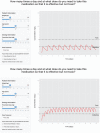Interactive Pharmacometric Applications Using R and the Shiny Package
- PMID: 26225240
- PMCID: PMC4394611
- DOI: 10.1002/psp4.21
Interactive Pharmacometric Applications Using R and the Shiny Package
Abstract
Interactive applications, developed using Shiny for the R programming language, have the potential to revolutionize the sharing and communication of pharmacometric model simulations. Shiny allows customization of the application's user-interface to provide an elegant environment for displaying user-input controls and simulation output-where the latter simultaneously updates with changing input. The flexible nature of the R language makes simulations of population variability possible thus promoting the combination of Shiny with R in model visualization.
Figures





References
-
- Bonate P. What happened to the modeling and simulation revolution? Clin. Pharmacol. Ther. 2014;96:416–417. - PubMed
-
- Wickham H. ggplot2: Elegant Graphics for Data Analysis. New York: Springer; 2009. . < http://had.co.nz/ggplot2/book >. ( )
LinkOut - more resources
Full Text Sources
Other Literature Sources

